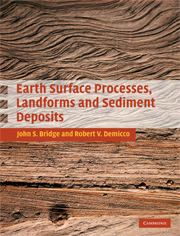Book contents
- Frontmatter
- Contents
- Acknowledgments
- Figure credits
- PART 1 Introduction
- PART 2 Production of sediment at the Earth's surface
- PART 3 Fundamentals of fluid flow, sediment transport, erosion, and deposition
- 5 Unidirectional turbulent water flow, sediment transport, erosion, and deposition
- 6 Air flow, sediment transport, erosion, and deposition
- 7 Multidirectional water flow, sediment transport, erosion, and deposition
- 8 Movement of sediment by gravity
- 9 Generation and movement of volcaniclastic sediment
- 10 Ice flow, sediment transport, erosion, and deposition
- 11 Biogenic and chemogenic depositional structures
- 12 Post-depositional deformation of soft sediment
- PART 4 Environments of erosion and deposition
- PART 5 Sediment into rock: diagenesis
- PART 6 Long-term, large-scale processes: mountains and sedimentary basins
- References
- Appendix: Methods of study of Earth surface processes, landforms, and sediments
- Index
- Plate section
9 - Generation and movement of volcaniclastic sediment
from PART 3 - Fundamentals of fluid flow, sediment transport, erosion, and deposition
Published online by Cambridge University Press: 05 June 2012
- Frontmatter
- Contents
- Acknowledgments
- Figure credits
- PART 1 Introduction
- PART 2 Production of sediment at the Earth's surface
- PART 3 Fundamentals of fluid flow, sediment transport, erosion, and deposition
- 5 Unidirectional turbulent water flow, sediment transport, erosion, and deposition
- 6 Air flow, sediment transport, erosion, and deposition
- 7 Multidirectional water flow, sediment transport, erosion, and deposition
- 8 Movement of sediment by gravity
- 9 Generation and movement of volcaniclastic sediment
- 10 Ice flow, sediment transport, erosion, and deposition
- 11 Biogenic and chemogenic depositional structures
- 12 Post-depositional deformation of soft sediment
- PART 4 Environments of erosion and deposition
- PART 5 Sediment into rock: diagenesis
- PART 6 Long-term, large-scale processes: mountains and sedimentary basins
- References
- Appendix: Methods of study of Earth surface processes, landforms, and sediments
- Index
- Plate section
Summary
Introduction
Volcanoes cover only a small proportion of the Earth's land surface, and periods of activity of individual volcanoes are orders of magnitude less than inactive periods. The restricted spatial distribution and period of activity of volcanoes belie the importance of their effect on the Earth's surface, and specifically on (1) the chemical composition of the oceans and atmosphere; (2) the generation of airborne and waterborne volcanic sediment; (3) Earth's climate, through their effect on gaseous and particulate matter in the atmosphere; (4) generation of volcanic sediment gravity flows and tsunami; (5) the formation of distinctive topography that influences directions of fluid flow and sediment transport, including diversion of rivers and formation of lakes; and (6) destruction of many forms of life. As discussed in Chapter 2, the evolution of the Earth's lithosphere, atmosphere, hydrosphere, and biosphere, and major topographic features such as oceans and mountains, are intimately associated with volcanism and tectonism.
There is great variability in the topography associated with volcanoes, in the manner of eruption, in the composition and texture of the material erupted, and in the mode of transport of the erupted material. Furthermore, these features can vary with time, and even during a single eruption. Volcanic eruption may be in the form of relatively non-violent effusions of lava (as with Hawaiian volcanoes) or by violent explosions (as during the 1991 eruption of Mt. Pinatubo in the Philippines). Volcanic eruptions can take place into the atmosphere or into water, or both.
- Type
- Chapter
- Information
- Earth Surface Processes, Landforms and Sediment Deposits , pp. 278 - 291Publisher: Cambridge University PressPrint publication year: 2008
- 1
- Cited by



